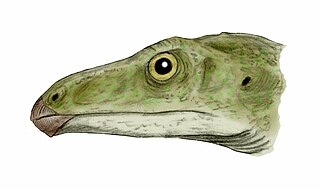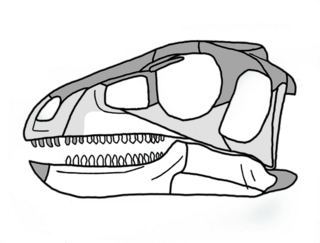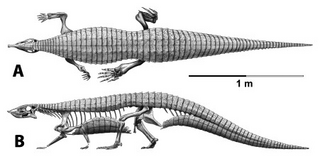Eucoelophysis is a genus of silesaurid dinosauriform from the Late Triassic (Norian) period Chinle Formation of New Mexico. It was assumed to be a coelophysid upon description, but a study by Nesbitt et al. found that it was actually a close relative of Silesaurus, which was independently supported by Ezcurra (2006), who found it to be the sister group to Dinosauria, and Silesaurus as the next most basal taxon.

Revueltosaurus is an extinct genus of suchian pseudosuchian from Late Triassic deposits of New Mexico, Arizona and North Carolina, United States. Many specimens, mostly teeth, have been assigned to Revueltosaurus over the years. Currently, three species are included in this genus, all of which were originally thought to represent monospecific genera of basal ornithischian dinosaurs. Revueltosaurus was about 1 meter long.

Shuvosaurus is a genus of beaked, bipedal poposauroid pseudosuchian from the Late Triassic of western Texas. Despite superficially resembling a theropod dinosaur, especially the ostrich-like ornithomimids, it is instead more closely related to living crocodilians than to dinosaurs. Shuvosaurus is known by the type and only species S. inexpectatus, and is closely related to the very similar Effigia within the clade Shuvosauridae. Shuvosaurus was originally described from a restored skull and very few fragmentary postcranial bones as a probable ornithomimosaur, or at least a very ornithomimosaur-like early theropod. The true pseudosuchian affinities of Shuvosaurus were only recognised after the discovery of Effigia linked the skull of Shuvosaurus with similar poposauroid skeletal remains found in the same quarry.
Caseosaurus is a genus of saurischian dinosaur that lived approximately 221.5 to 212 million years ago during the latter part of the Triassic Period in what is now Texas, in North America. It was a small, lightly-built, bipedal, ground-dwelling carnivore, and could grow up to 2 m (6.6 ft) long.

Camposaurus is a coelophysid dinosaur genus from the Norian stage of the Late Triassic period of North America. The pertinent fossil remains date back to the early to middle Norian stage, and is widely regarded as the oldest known neotheropod.

Chindesaurus is an extinct genus of basal saurischian dinosaur from the Late Triassic of the southwestern United States. It is known from a single species, C. bryansmalli, based on a partial skeleton recovered from Petrified Forest National Park in Arizona. The original specimen was nicknamed "Gertie", and generated much publicity for the park upon its discovery in 1984 and airlift out of the park in 1985. Other fragmentary referred specimens have been found in Late Triassic sediments throughout Arizona, New Mexico, and Texas, but these may not belong to the genus. Chindesaurus was a bipedal carnivore, approximately as large as a wolf.

Crosbysaurus is a genus of extinct archosauromorph that lived in the Late Triassic of Arizona, New Mexico, North Carolina, Texas, and Utah. It is known from the Chinle Formation and Dockum Group rock units from the southwestern United States. The type species is C. harrisae, and the only known material includes teeth. 11 specimens are known, each including a single tooth.
Tecovasaurus (te-KOH-va-SAWR-us) is an extinct Late Triassic amniote genus of unknown affinities, known only from teeth. It was initially described as a basal ornithischian dinosaur, subsequently reclassified as a member of the clade Archosauriformes of uncertain phylogenetic placement (Irmis et al., and later, taking into account the similarity of its teeth to the teeth of traversodontid cynodonts such as Dadadon, as an amniote of uncertain affinities. It is named after the Tecovas Formation, in Texas and Arizona, which yielded the holotype remains.
Technosaurus is an extinct genus of Late Triassic silesaurid dinosauriform, from the Late Triassic Cooper Canyon Formation of Texas, United States.
Galtonia is an extinct genus of pseudosuchian from the Late Triassic. It is known from remains found in the Late Triassic-aged New Oxford Formation of Pennsylvania, which were first described by Edward Drinker Cope in 1878.
Spinosuchus is an extinct genus of trilophosaurid allokotosaur from the Late Triassic of Texas, southern United States. It has been assigned to a variety of groups over its history, from coelophysid dinosaur to pseudosuchian to uncertain theropod dinosaur and to Proterosuchidae. This uncertainty is not unusual, given that it was only known from a poorly preserved, wall-mounted, partial vertebral column of an animal that lived in a time of diverse, poorly known reptile groups. However, newly collected material and recent phylogenetic studies of early archosauromorphs suggest that it represents an advanced trilophosaurid very closely related to Trilophosaurus.
Krzyzanowskisaurus is the name given to a genus of archosaur from the Late Triassic-aged Chinle Formation and it is a tooth taxon, based on fossils only of teeth and these teeth have been found in the U.S. states of Arizona and New Mexico. The original report described it as a "probable ornithischian" and Heckert (2005) suggests that Krzyzanowskisaurus teeth have biostratigraphic utility as an index fossil of the St. Johnsian sub-LVF.

Pisanosaurus is an extinct genus of early dinosauriform, likely an ornithischian or silesaurid, from the Late Triassic of Argentina. It was a small, lightly built, ground-dwelling herbivore, that could grow up to an estimated 1 m (3.3 ft) long. Only one species, the type, Pisanosaurus mertii, is known, based on a single partial skeleton discovered in the Ischigualasto Formation of the Ischigualasto-Villa Unión Basin in northwestern Argentina. This part of the formation has been dated to the late Carnian, approximately 229 million years ago.

Dinosauromorpha is a clade of avemetatarsalians that includes the Dinosauria (dinosaurs) and some of their close relatives. It was originally defined to include dinosauriforms and lagerpetids, with later formulations specifically excluding pterosaurs from the group. Birds are the only dinosauromorphs which survive to the present day.

Stagonolepis is an extinct genus of stagonolepidid aetosaur known from the Late Triassic Hassberge Formation of Germany, the Drawno Beds of Poland, and the Lossiemouth Sandstone of Scotland. Supposed fossils from North and South America have been placed into their own genera, Calyptosuchus and Aetosauroides, respectively.

Acaenasuchus is an extinct genus of pseudosuchian, endemic to what would be presently be known as Arizona during the Late Triassic, specifically during the Carnian and Norian stages of the Triassic. Acaenasuchus had a stratigraphic range of approximately 11.5 million years. Acaenasuchus is further categorized as one of the type fauna that belong to the Adamanian LVF, based on the fauna of the Blue Mesa Member of the Chinle Petrified Forest Formation of Arizona, where Acaenasuchus was initially discovered.

Machaeroprosopus is an extinct genus of mystriosuchin leptosuchomorph phytosaur from the Late Triassic of the southwestern United States. M. validus, once thought to be the type species of Machaeroprosopus, was named in 1916 on the basis of three complete skulls from Chinle Formation, Arizona. The skulls have been lost since the 1950s, and a line drawing in the original 1916 description is the only visual record of the specimen. Another species, M. andersoni, was named in 1922 from New Mexico, and the species M. adamanensis, M. gregorii, M. lithodendrorum, M. tenuis, and M. zunii were named in 1930. Most species have been reassigned to the genera Smilosuchus, Rutiodon, or Phytosaurus. Until recently, M. validus was considered to be the only species that has not been reassigned. Thus, Machaeroprosopus was considered to be a nomen dubium or "doubtful name" because of the lack of diagnostic specimens that can support its distinction from other phytosaur genera. However, a taxonomic revision of Machaeroprosopus, conducted by Parker et al. in 2013, revealed that UW 3807, the holotype of M. validus, is not the holotype of Machaeroprosopus, while the species Machaeroprosopus buceros, Machaeroprosopus being a replacement name, with a fixed type species, for Metarhinus, is the combinatio nova of the type species of the genu: Belodon buceros. Therefore, the name Pseudopalatus must be considered a junior synonym of Machaeroprosopus, and all species of the former must be reassigned to the latter. This revised taxonomy was already accepted in several studies, including Stocker and Butler (2013). Stocker and Butler (2013) also treated M. andersoni as a valid species, and not a junior synonym of Machaeroprosopus buceros as was previously suggested by Long and Murry (1995).
Tecovasuchus is an extinct genus of aetosaur. It is known primarily from osteoderms found from the Tecovas Formation in Texas, which is Late Triassic in age, dating back to the lower Norian. Material is also known from several other localities of the Chinle Group in New Mexico and Arizona, such as older Carnian outcrops and younger Rhaetian outcrops. Specimens of Tecovasuchus have been collected from the Tecovas Formation, the Bluewater Creek Formation, and the Los Esteros Member of the Santa Rosa Formation.
The Colorado City Formation is a Late Triassic geologic formation in the Dockum Group of Texas, United States. It has previously been known as the Iatan Member, Colorado City Member or 'Pre-Tecovas Horizon'.









